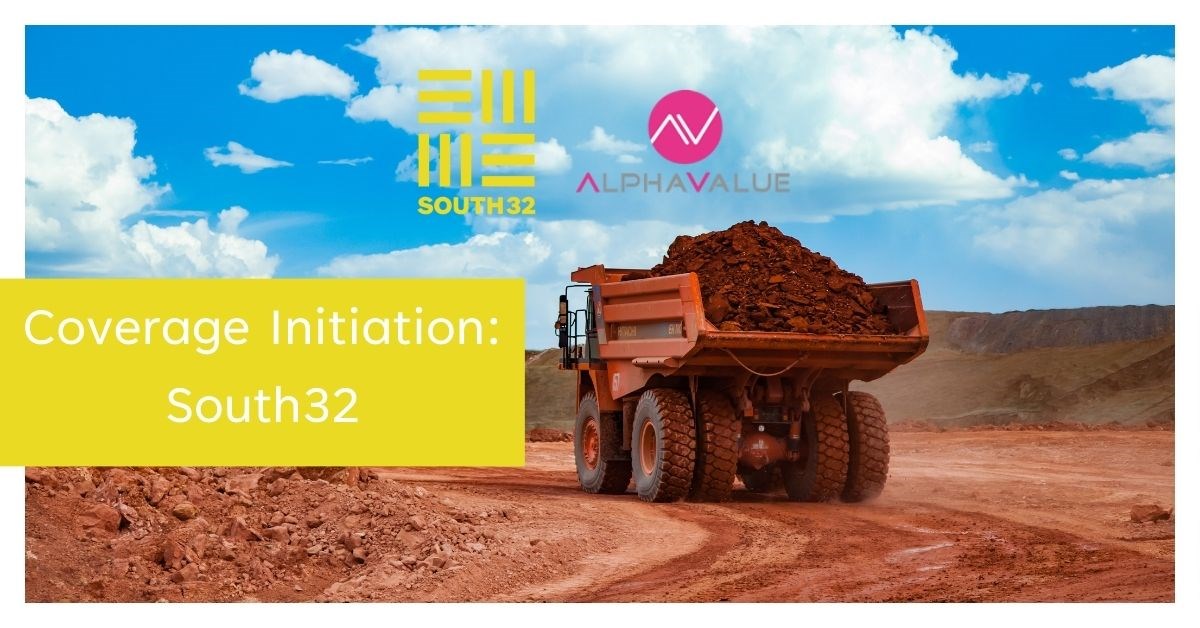
Coverage Initiation: South32
We initiate coverage of South32 with an ADD rating. Since the outbreak of the pandemic, there has been a dash for the future-facing metals which are expected to play a big role in global green transition initiatives. South32 is a big beneficiary of this trend and has seen substantial/strategic changes in its business mix since its inception. Future-facing metals account for c.80% of group sales and, moreover, Chinese business exposure – a major sector-wide risk – is relatively small. In addition to the above, a promising mix of planned (growth) investments also makes South32 an attractive bet.
| Target Price |
Credit Risk |
Fundamental Strength |
Sustainability Score |
Independent Board |
| 234 |
A |
4/10 |
5/10 |
No |
Businesses & Trends
South32 stock price momentum
South32 is an Australia-incorporated ‘non-ferrous’ diversified miner, established in May 2015 post a demerger from BHP Group (the world’s largest miner in market cap terms). Its focus commodities comprise bauxite, alumina, aluminium, copper, manganese, metallurgical coal, nickel, silver and zinc. Group-level production in FY23 (June-ending) stood at 1.5mt – in copper equivalent terms. South32 has a primary stock market listing in Australia, and secondary listings on the Johannesburg and London stock exchanges, with a 100% free float.
Transparent accounts
While South32’s ownership of assets is like most sector constituents i.e. a mix of fully- and co-owned assets, the firm has a ‘clean’ set of accounts, wherein the operating results are reported on a pro-rated basis. In effect, there’s transparency w.r.t the firm’s ‘actual’ earnings/cashflows – i.e. EBITDA is the same as ‘controlled’ EBITDA, which results in a more accurate assessment of the ‘real’ funds available for both growth initiatives and shareholder rewards. This is in contrast with many peers, where a sizeable chunk of value is (generally) attributed/lost to minority shareholders – particularly true when the attractiveness of cash-rich subsidiaries is over-stated.
A future-facing metals proposition
In top-line terms, aluminium (FY23 attributable output of 1.1mt; 1.6% of global output) is the most-important contributor – accounting for almost one-half of group sales (including associates and JVs), followed by met coal (5.5mt; 0.5%), manganese (5,653kwmt; c.28%), nickel (41kt; 1.2%), copper (71kt; 0.3%), zinc (59kt; 0.5%), silver (11,813koz; 1.4%) and lead (102kt; 2.3%). In response to the rapidly-changing market demand dynamics, the sales mix has altered materially since the company’s inception (illustrated below) – particularly considering the firm’s exit from thermal coal, which is a re-emerging concern for many (big) miners. Interestingly, future-facing metals like aluminium, copper, nickel and manganese account for c.80% of FY23 group-level sales (including associates and JVs).
Stable operating assets exposure
Like Rio-BHP i.e. the iron ore majors in AV coverage, South32 has a sizeable operational presence in Australia, accounting for c.48% of non-current assets, which is inevitably a function of its BHP legacy. However, unlike the former, the latter has ‘NIL’ iron ore exposure and its Aussie operations primarily comprise alumina, manganese, zinc and met coal assets. The next big operating geography is the US (c.11%) – excluding the Netherlands (c.15%), which is attributed to a shareholder loan receivable for one of South32’s financing arms – followed by South Africa (c.8%), Brazil (c.7%) and Mozambique (c.5%). In a nutshell, the firm’s operating assets are somewhat skewed towards the natural resources-rich parts of the developed world, which thereby reduces (operational) the vulnerabilities associated with developed/frontier markets – a key concern during (severe) macro downturns.
Growth pipeline
Source: South32 FY23 Investor Presentation
Via various initiatives, South32 is well-positioned to grow its exposure to future-facing metals and simultaneously reduce met coal dependency. Importantly, unlike many peers, more than half the projects are being pursued in developed markets where operating conditions tend to be more benign. Moreover, given these mature economies’ critical materials dependencies – especially on China (amid a brewing West vs. China divide) – the approval process and/or the lead time to get these projects up and running is likely to be expedited.
Investment case risks
1/ a severe macro-economic downturn beyond China;
2/ delayed implementation of green transition plans, especially in developed markets;
3/ postponement of the aluminium value chain clean-up, thereby diluting the green metals proposition;
4/ operational risks for non-operated assets.
To access the whole research, do not hesitate to contact us.
Subscribe to the AlphaValue blog to stay up to date with our recent research.
Subscribe to our blog

2026 starts as your typical financial year with high eps growth ambitions (+11%), most likely to be tri...

